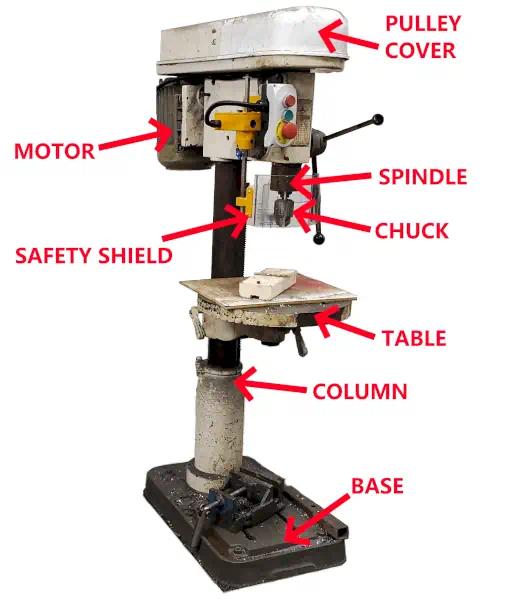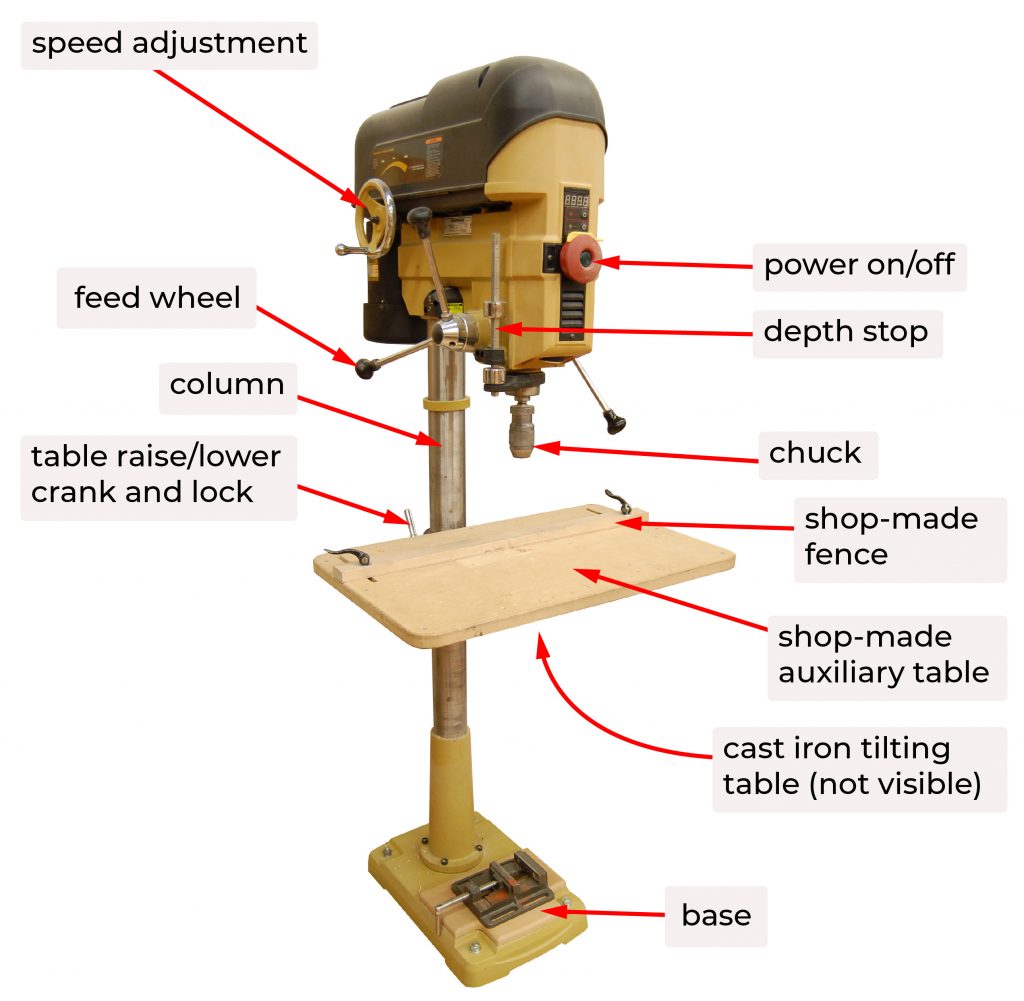When it comes to using a drill press, one question often pops up: “Does a drill press need to be bolted to the floor?” It’s an interesting query, and in this article, we’re going to explore the answer in detail. So, strap in and let’s dive right in!
Imagine this: you’re in your workshop, ready to tackle a DIY project or indulge in some serious woodworking. You bring out your trusty drill press, but then you start to wonder, “Should I bolt it down?” Well, my friend, the answer isn’t as straightforward as you might think. There are a few factors at play that determine whether or not your drill press needs to be securely fastened.
So, are you ready to find out what those factors are and get some clarity on the matter? Great! In this article, we’ll discuss the benefits of bolting your drill press to the floor, the situations where it’s necessary, and when you can get away without doing so. Let’s get started on this fascinating journey into the world of drill presses!
A drill press does not necessarily need to be bolted to the floor, but it is highly recommended for stability and safety. Bolting the drill press to the floor prevents it from tipping over during operation, especially when drilling large or heavy materials. Additionally, it reduces vibrations and enhances precision. While it is not a requirement, securing a drill press to the floor is a good practice that ensures a sturdy and reliable workspace.

Does a Drill Press Need to Be Bolted to the Floor?
When it comes to using a drill press, many people wonder whether it needs to be bolted to the floor. This question is especially common among DIY enthusiasts and hobbyists who may not have access to a permanent workshop. In this article, we will explore the benefits of bolting a drill press to the floor, the alternatives to bolting, and provide tips for using a drill press safely and effectively.
The Benefits of Bolting a Drill Press to the Floor
One of the primary advantages of bolting a drill press to the floor is stability. By securing the drill press to a solid surface, you can minimize vibrations during operation, leading to more precise and accurate drilling. This is particularly important when working with delicate materials or when drilling precise holes that require a steady hand.
In addition to stability, bolting a drill press to the floor also offers enhanced safety. A securely mounted drill press reduces the risk of the machine tipping over or moving unexpectedly during operation. This can prevent accidents and injuries, providing peace of mind for the user.
Furthermore, when a drill press is bolted to the floor, it creates a dedicated and ergonomic workspace. The machine remains in a fixed position, allowing the user to focus on the task at hand without the need to constantly readjust or stabilize the drill press. This can improve efficiency and productivity, especially for those who frequently use the drill press for various projects.
Alternatives to Bolting a Drill Press
While bolting a drill press to the floor offers numerous benefits, it may not always be feasible or necessary. There are alternative options available that can provide stability and safety without the need for permanent floor mounting.
One popular alternative is to use a drill press stand or a workbench. These portable setups provide a stable platform for the drill press while still allowing for mobility and flexibility. A drill press stand or a workbench can be securely clamped or bolted to a table or work surface, offering stability during operation.
Another option is to use weight plates or sandbags to secure the drill press. Placing additional weight on the base of the drill press can help stabilize the machine and reduce vibrations. This method is particularly useful for those who frequently need to move their drill press or do not have a dedicated workspace.
Lastly, using anti-vibration pads or mats underneath the drill press can help minimize vibrations and provide a more stable work surface. These pads absorb and dampen vibrations, allowing for smoother and more accurate drilling.
Tips for Using a Drill Press Safely and Effectively
Whether you choose to bolt your drill press to the floor or opt for an alternative method, there are some general tips and guidelines to follow to ensure safe and effective use of the machine.
1. Wear appropriate safety gear:
Always wear safety glasses, ear protection, and snug-fitting clothing when operating a drill press. Additionally, use a dust mask when drilling into materials that may produce airborne particles.
2. Secure the workpiece:
Always secure the workpiece firmly using clamps or other appropriate methods. This ensures that the workpiece does not move or spin during drilling, reducing the risk of accidents.
3. Choose the right speed and drill bit:
Select the appropriate drilling speed and drill bit for the material you are working with. Different materials require different drilling speeds and types of drill bits for optimal results. Consult the drill press manual or reference guides for recommendations.
4. Maintain the drill press:
Regularly clean and lubricate the drill press to keep it in good working condition. Follow the manufacturer’s instructions for maintenance and make any necessary adjustments or repairs as soon as possible.
5. Stay focused and attentive:
Always pay attention to your surroundings and remain focused on the task at hand while operating the drill press. Avoid distractions and take regular breaks to prevent fatigue or loss of concentration, which can lead to accidents.
6. Seek professional help if needed:
If you are unsure about a certain project or task, it is always best to seek guidance from a professional or experienced individual. They can provide valuable advice and ensure that you are using the drill press safely and effectively.
Conclusion
Whether you choose to bolt your drill press to the floor or explore alternative methods, it is essential to prioritize stability and safety. Bolting a drill press offers increased stability, safety, and an ergonomic workspace. However, alternatives such as drill press stands, weight plates, and anti-vibration pads can provide similar benefits without the need for permanent floor mounting. Regardless of the method chosen, always follow safety guidelines and use the drill press in a responsible manner.
Key Takeaways: Does a Drill Press Need to be Bolted to the Floor?
- A drill press doesn’t necessarily need to be bolted to the floor, but it is recommended for stability and safety purposes.
- By bolting a drill press to the floor, it reduces vibrations and movement, allowing for greater precision during drilling.
- Bolting also ensures the drill press stays in place, preventing accidents or damage from unexpected movements.
- If you have limited space or need to move the drill press frequently, you can use weighty alternatives like sandbags or mounting it on a sturdy workbench.
- Regardless of bolting or other methods, always ensure the drill press is securely fixed to prevent any accidents or mishaps.
Frequently Asked Questions
Are you wondering whether a drill press needs to be bolted to the floor? Below, we have answered some common questions to help you understand this topic better.
Is it necessary to bolt a drill press to the floor?
While it is not absolutely necessary to bolt a drill press to the floor, it is highly recommended for several reasons. Bolting the drill press to the floor increases stability, reducing vibrations and ensuring more accurate drilling. It also adds an extra layer of safety by preventing the drill press from tipping over or shifting during operation.
Bolting the drill press down is especially important for larger, more powerful models that generate higher levels of torque and vibrations. Additionally, if you plan on using the drill press for heavy-duty tasks or prolonged periods, bolting it to the floor will provide a secure foundation for optimal performance.
Can I use a drill press without bolting it down?
Yes, you can still use a drill press without bolting it down. However, keep in mind that without bolting, the stability will be compromised. This can result in more vibrations, reduced accuracy, and potentially unsafe drilling conditions. If you choose not to bolt down your drill press, ensure you have a sturdy, level workbench or table that can handle the vibrations and weight of the machine.
For lighter drilling tasks or occasional use, not bolting the drill press may be sufficient. However, if precision and safety are essential to your work, it is recommended to bolt the drill press to a stable surface.
What are the benefits of bolting a drill press to the floor?
Bolting a drill press to the floor provides several benefits. First and foremost, it enhances stability, reducing vibrations and ensuring more accurate drilling. The drill press will stay securely in place, improving the quality of your work and reducing the risk of mistakes.
Additionally, bolting the drill press to the floor adds an extra layer of safety. It prevents the machine from tipping over or shifting during operation, minimizing the chances of accidents or injuries. The stability provided by the bolts also ensures that the drill press stays properly aligned, reducing wear and tear on the machine over time.
What type of floor is suitable for bolting a drill press?
A drill press can be bolted to various types of flooring materials, as long as they are stable and capable of supporting the weight of the machine. Concrete floors are commonly used for bolting drill presses, as they provide excellent stability and durability.
If you have a wooden floor, ensure it is thick and sturdy enough to handle the weight and vibrations of the drill press. It is also important to check for any underlying structural supports to ensure they can provide adequate stability.
Can I use alternatives to bolting a drill press to the floor?
If you are unable to or prefer not to bolt your drill press to the floor, there are alternative methods to enhance stability. One option is to use a specially designed drill press stand or cart, which provides a stable base and reduces vibrations. These stands often have adjustable heights and are portable, allowing you to move the drill press as needed.
Another alternative is using vibration-absorbing pads or mats placed under the drill press. These pads help reduce vibrations and stabilize the machine, offering a safer and more precise drilling experience. However, keep in mind that these alternatives may not provide the same level of stability as bolting the drill press to the floor.

“H2″HTML tag: Summary
If you have a drill press, it’s a good idea to bolt it to the floor. This will make it more stable and reduce the risk of accidents. Bolting the drill press will also help to minimize vibrations, making your drilling more accurate and efficient. However, if you don’t have the option to bolt it down, using a heavy-duty stand or bench can also provide stability.
Remember to always wear safety glasses and follow the manufacturer’s instructions when using a drill press. Keep your workspace clean and organized to avoid any potential hazards. By taking these precautions, you can enjoy safe and successful drilling projects with your drill press.
